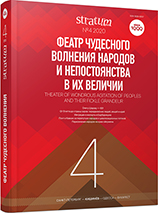Финал могильника Фронтовое 3 (к изучению миграций в Юго-Западном Крыму на закате античности)
The Finale of Frontovoye 3 Burial Ground (on the study of migrations in the South-Western Crimea at the Demise of Antiquity)
Author(s): Igor O. Gavritukhin, Anna V. Mastykova, Alexey N. Sviridov, Evgeny V. Sukhanov, Sergey V. YazikovSubject(s): History, Archaeology, Ancient World, Migration Studies
Published by: Издательский дом Stratum, Университет «Высшая антропологическая школа»
Keywords: Crimea; Roman period; Great Migrations period; burial grounds; chronology; migrations
Summary/Abstract: The paper presents a discussion on the chronological indicators and features of the latest complexes of Frontovoye-3 burial ground (Nakhimovsky district, Sevastopol). This cemetery appeared around the end of the 1st century AD; it was completely investigated in 2018 (328 graves of the Roman time). The latest finds (some types of elements of belt sets, a glass cup with blue blobs) are dated around the beginning of the 5th century. In the extreme South-West of the burial ground, three groups of graves of the last quarter of the 4th — beginning of the 5th century have been distinguished. Similar date is represented by a number of other burial places of the South-Western and Piedmont Crimea. Obviously, the appearance of the Huns to the West of the Don (in 375 AD at the latest) and the resulting migrations had not initially affected the Crimea. Cemeteries of the settled population of the Piedmont Crimea and a number of cemeteries in the South-Western Crimea cease to function in the late 4th or early 5th century AD. Some of this population moved to the Southern coast of the Crimea, while the other founded several new cemeteries in the South-West Crimea.
Journal: Stratum plus. Археология и культурная антропология
- Issue Year: 2020
- Issue No: 4
- Page Range: 235-247
- Page Count: 13
- Language: Russian
- Content File-PDF

